#herbivores
Text

stegosaurus stenops🌿🌿🌿
#illustration#digital art#art#aesthetic#illustrators on tumblr#animals#character design#dinosaur#paleoart#paleontology#paleoblr#paleomedia#artists on tumblr#dinosaurs#paleoposting#paleo tag#stegosaurus#herbivores
688 notes
·
View notes
Text

Grand Plains encounter
#path of titans#dinosaurs#herd#herbivores#server shenanigans#lambeosaurus#styracosaurus#albertaceratops#struthiomimus#camptosaurus#ampelosaurus#small guy i have no idea what the hek is that#the herd is wondering too#edit: BABY DILO!!!
366 notes
·
View notes
Note
What makes an animal a herbivore? We would all agree that bunny’s are herbivore but they regularly will eat there dead babies to prevent smelling does that make them omnivore. Infact all herbivores are capable of digesting meat so does that mean there is no sush thing as herbivore?
A herbivore is just an animal who is adapted to eating plant material for the main component of their diet. They eat mostly plants, but may not eat plants exclusively, the same is true of carnivores and meat. Keep in mind that these are really just taxonomy groupings we have imposed on the natural world to help us better categorise them. It is more of a ‘best-fit’ system than an absolute biological determination.
This is part of why I find the insistence that humans as omnivores in some way morally justifies or physically necessitates eating meat to be particularly silly as an argument. That said, vegans deep diving into human physiology to try to prove that we are herbivores and therefore ‘should’ be vegan is a bit misguided in my opinion, for the same reason.
30 notes
·
View notes
Note
Just kind of curious and wondered if we have or could there have been any dinosaurs that were omnivores? We have fossils of true canivores that ate meat and herbivores that ate plants but were there any dinos that were sort of like the bears and raccoons of their time that ate both meat and plants and/or just whatever they came across?
tons were!!! first off, very few things are hypercarnivores or hyperherbivores - most animals are in the spectrum, and supplement their diets (this is why dogs can have a little plant matter as a treat but cats are a no go - cats are complete predators, dogs just a smidge less so). We see lots of herbivores today eating carcasses, for example. So we can assume most dinosaurs were omnivorous in some capacity
then, beyond that, we have some dinosaurs that make the most sense as omnivores - the Oviraptorosaurs and Troodontids, for one, but also possibly others like Ornithomimosaurs and Pachycephalosaurs! We're always learning new things. there's a whole growing field where we determine diet from isotopes, and that may yet reveal more omnivores!
62 notes
·
View notes
Text
apropos of another weird anti-grass post is that one thing i feel like should be common knowledge, but know very well isn't, is that mowing your lawn is an act simulating the symbiotic relationship grass has with grazing animals.
like. grass is eaten by grazing animals; it's one of the primary foodstuffs of creatures with teeth and stomachs that are up to the job, because it's so plentiful. a cow is a grass-predator. you'd think that would make cow the enemy of grass.
but grass is optimized to be browsed and walked on. it absorbs that shit like it's nothing, up to the point that these activities start either damaging the root-mat or cutting back the new growth so early that the plant doesn't have enough leaves to eat with.
but the rivals of grass are not so much so optimized. most non-grass meadow plants that don't pretty much lie flat (i'm generalizing wildly here obvs) have stems they depend on, that can be snapped much more easily than the vascular systems of most grasses, especially short ones, and have to start all over again if you compromise the stem an inch off the ground.
and trees, whew. a tree sprout that gets bitten off is just done. it shot its shot.
which means that grass benefits from grazing animals about as much as those animals benefit from grass. they maintain each other.
grass doesn't grow because it inherently wants to be tall. it is, fundamentally, indifferent to tall. it wants sun access, so it can eat, and if it stops growing it'll be in the shade of everybody else, so it goes for it. if everyone is getting sheared off a little above the ground, grass is winning. because grass copes with that like a champion.
and grass-dominated meadow is absolutely a valid biome, and one of the most natural environments for humans.
so mowing a lawn in order to keep it conveniently walkable and mostly-grass is like. technically inferior to hiring some goats like the Mortifying Ordeal guy, if only that could be made a convenient routine transaction and if you were willing to endure the botanically desirable side effect of goat shit. but a perfectly reasonable maintenance method for a small patch of earth you aren't actively cultivating to any other purpose. and cultivating all land all the time is a dumb unsustainable goal and i don't like it.
mowing is fine. grass, ideally local grass, basically anywhere not a desert is splendid.
it's the poisons that are literally just an offense against man and nature.
#dousing your lawn in herbicides and pesticides is like#white supremacy for plants#although honestly i think the anti-grass backlash is more like the#'all masculinity is toxic' movement#anyway#lawn culture#the circle of life#grass#grasses#hoping this does not somehow become a pokemon post like my last grass rant#hoc est meum#herbivores
464 notes
·
View notes
Text
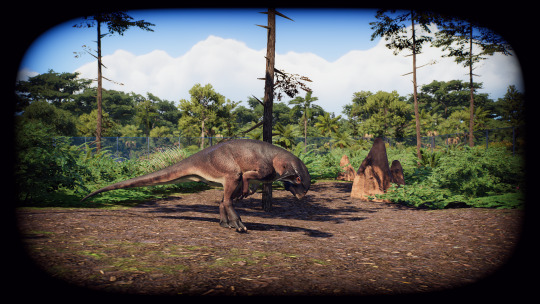


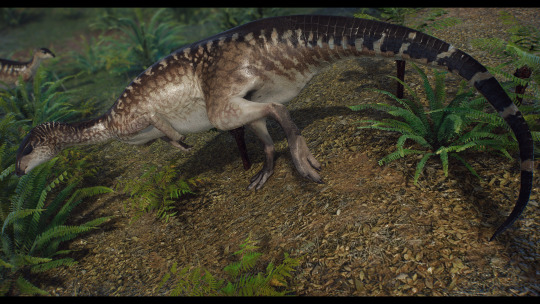




Pictures I took for the game during the many months it has been out, however I deleted a lot of my images during that time span as well.
I heavily enjoy taking pictures in any game but especially this one! I can not afford a camera to take pictures of extant dinosaurs so might as well do the next best thing right? Thank you for giving me the opportunity to take pictures of dinosaurs PK!
#pk#prehistoric kingdom#dinosaurs#game photography#in game photography#video games#extinct animals#paleoart#dryosaurus#psittacosaurus#protoceratops#herbivores#dinosaur game
25 notes
·
View notes
Text
In case you missed it, there's been a second successful cloning of a highly endangered takhi, also known as Przewalski's horse. The new foal is a clone of a stallion whose genetic material was collected four decades ago. It's the first time any species has had more than one successful cloning, and it bodes well for being able to bolster populations with the genes of animals that have long since passed away, thereby increasing overall genetic diversity of the species.
The takhi is the only true wild horse; the tarpan went extinct early in the 20th century, though it is debatable whether these were truly wild, or simply feral domestic horses like today's mustangs and brumbies. While there has been much discussion as to whether takhi are a separate species from the domestic horse, evidence points in that direction. This includes the fact that the takhi has 66 chromosomes, compared to the domestic horse's 64 (oddly enough, they can interbreed and produce fertile offspring that have 65 chromosomes.)
Takhi went extinct in the wild in the 1960s due to overhunting and competition with domestic horses and other livestock, and have suffered multiple genetic bottlenecks since then as populations fluctuated as low as twelve individuals worldwide. Of the 2000 or so left in the world, fewer than 500 live in the wild, and all wild populations are due to reintroductions to sites in Mongolia, Kazakhstan, and China. Ongoing reintroduction efforts are crucial to the survival of this ancient species.
#Przewalski's horse#takhi#horse#wild horses#wildlife#animals#herbivores#ungulates#mammals#extinction#endangered species#cloning#nature#ecology#restoration ecology#environment#conservation
42 notes
·
View notes
Text


Wonderful, Godlike… Thescelosaurus
Museum of World Treasures • Wichita, KS
#Thescelosaurus#dino#dinos#dinosaur#dinosaurs#museum of world treasures#herbivores#fossils#fossil#paleontology#my pix
54 notes
·
View notes
Text
The Siberian Unicorn

Reconstruction of an Elasmotherium, an extinct species of rhino that lived in the Eurasian area in the Late Pliocene and Pleistocene eras (around 39,000 years ago).
This animal could have been the basis for the unicorn myth that has persisted for thousands of years.
The Giant Siberian Unicorn, also known by its scientific name, Elasmotherium (E. sibiricum), is an extinct species of giant rhinoceros that had an extremely large horn on its forehead and a body covered in shaggy fur.
It was first named by Johann Gotthelf Fischer von Waldheim (13 October 1771 – 18 October 1853) in 1808. He was the director of the Natural History Museum in Moscow.
The Giant Siberian Unicorn was about the size of a mammoth. However, early reports say this beast weighed up to 4 tonnes, stood at 6.5 feet tall, and was about 14.76 feet long.
It has been debated on if this animal would gallop like a horse or would walk hunched over with his head to the ground like a bison.
The beast's front feet were larger than the rear and it had just three digits.
It is also debated on whether it had a giant horn on its head or not. Most experts believe it did as there is reasonable evidence of it having a horn based on the skulls they have found.
The skulls had a protuberance that suggested it was the base of a large horn.
The use of this horn could have been to dig for food, attract mates, and for self-defense.
It is believed that their horns and hooves were made of keratin — that is, if the horns did exist.
The Giant Siberian Unicorn lived in the Eurasia region during the late Pliocene and Pleistocene periods.
Giant rhinos have been documented from as late as 2.6 million years ago.
A skull was found in 2016 that was perfectly preserved and was of a very old male.
The skull was found in the Pavlodar region of Kazakhstan. It was proven that they died out just 29,000 years ago.
Previously, it was believed they died out around 350,000 years ago, which means they were around when early humans were alive.
From looking at their teeth, it is believed the Siberian Unicorns were herbivores with a diet of grass, plant bulbs, and tubers.
They think this creature could have used its horn to dig up plant bulbs and tubers to eat while also grazing on grass.
Weighing four tons means it would have to eat a lot, so it is thought they would travel miles just grazing and digging up plants to eat.
It is still unclear what caused the death of these beautiful giants.
Little evidence has shown us how they died out, however, scientists believe it could have been environmental factors that resulted in their extinction.
Others believe it could be due to having such a restricted diet or being a “picky eater.”
After the Ice Age ended, the grasslands began to shrink, causing fewer areas for the giant rhino to eat.
Human hunting may also have a hand in its extinction.
Natural History Museum, Moscow
#Elasmotherium#Siberian Unicorn#rhinoceros#Late Pliocene#Pleistocene#Giant Siberian Unicorn#Johan Fisher von Waldheim#Natural History Museum#horn#herbivores#extinction#Eurasia#palaeontology#fossil record#fossils#saint of the day#Moscow#Russia
7 notes
·
View notes
Photo
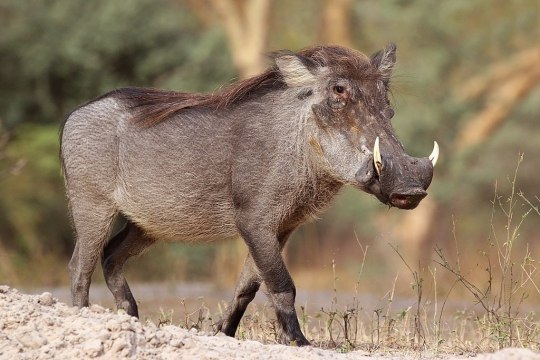
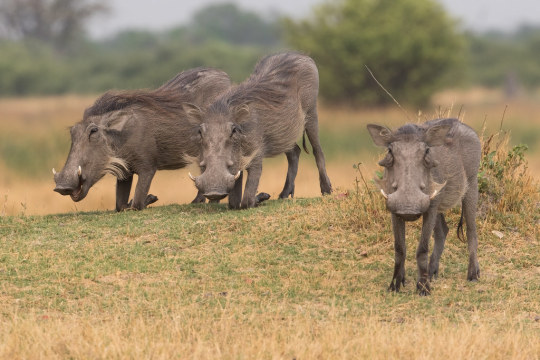

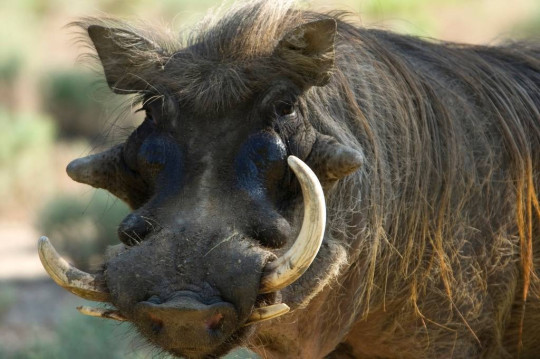
Wandering with the Warthog
Perhaps most famously known for their role in the US animated film The Lion King, the common warthog (Phacochoerus africanus) is a species of warthog endemic to sub-Saharan Africa. Its sister species, the desert warthog (Phacochoerus aethiopicus) is limited to the Horn of Africa’s deserts. Both live in arid scrublands and woodlands; the common warthog also thrive in savannahs, and are the only pig to do so. Both species are also omnivorous, feeding on grass and shrubs, roots, insects, and carrion. They, in turn, are prey for lions, leopards, and cheetahs.
Members of the warthog genus are highly social. Females and their young live in groups called “sounders”, which travel around a home range guarded by a solitary male. Often females bond, raising their young together and sometimes mounting each other while in heat. These bonds can extend to protecting each other from predators and even potential male mates. Males can also form social bonds, although they tend to remain solitary outside the breeding season.
Rutting begins at the end of the rainy season, around June, and continues until the end of the dry season in November or December. During the rut, male boars will seek out female burrows and defend them against other boars. However, typically only the duller upper tusks are used for fighting; the sharper lower ones are saved for predators. Both males and females mate with multiple partners, and males provide no parental care, leaving soon after. Gestation lasts for about 5-6 months, after which females give birth in a burrow separate from the rest of the group. Litters for the common warthog can be as large as 8 piglets, while desert warthogs give birth to only 2 or 3. However, mothers in both species have been observed “allosucking“, or allowing piglets other than their own children to suckle. Piglets take about 6 months to fully wean, although they stay close to their mother until they are fully grown at about 2 years old. Warthogs can live anywhere from 11 to 18 years old.
Both Phacochoerus species are about medium sized, between 63-85cm tall at the shoulder and weighing about 45-75 kilos, with males usually larger than females. Individuals can be coloured grey, brown, or black, and usually sport a coarse mane and brush-like tail that flares up as a warning to predators. Warthogs are also known for their distinctive tusks; both males and females have two pairs that protrude from the mouth and curl upwards. The lower pair is shorter than the upper pair and sharpens by rubbing against the upper pair every time the warthog moves its mouth. P. africanus can be distinguished from P. aethiopicus by their facial features; P. aethiopicus lacks insicors, has a larger snout, and the tips of their ears curl back.
Conservation status: Warthogs are considered Least Concern by the IUCN. Many areas of both species’ range is occupied by parks where they are protected. However, both habitat loss and poaching for ivory are common problems.
Photos
Charlie J. Sharp (via wikipedia)
Michel Gutierrez (via Flickr)
Bernard Dupont
Joel Sartore
#common warthog#desert warthog#Artiodactyla#Suidae#warthogs#pigs#swine#even-toed ungulates#ungulates#herbivores#mammals#grasslands#grassland mammals#scrubland#scrubland mammals#deserts#desert mammals#deciduous forests#deciduous forest mammals#savannah#savannah mammals#africa#sub-Saharan Africa#east africa#animal facts#zoology#biology#queer animals#queer fauna
356 notes
·
View notes
Text
literally every single terrestrial creature on this planet that's mouse sized or larger will see a mouse and eat it
72 notes
·
View notes
Text

HAPPY NEW YEAR
{yay herbies!}
Thank you all for the visits, the likes, the reblogs, just passing by is already a great gift you gave me during 2023 despite my lack of activity on here! So truely, thank you for everything again and for the wonderful shares, always appreciated and really heartwarming of you!
Once again i might redirect you through my INSTAGRAM to get through some more activities, not that i’m leaving this tumblr down, but i’m more active on those platform! Plus you’d get to know when i’m available or not for COMMISSIONS if you’re interested ♥
My best wishes to y’all for 2024, let’s all hope it’s gonna be an even better year than the last one was! Have a good day/night depending when you’re reading this!
Cheers y'all ♥
» Ripple © CeindraTheJiiva.
» Jasper, Elvis, Polly, Tootsy, Art © Hopie.
#Rioteers#DinoArt#PaleoArt#DigitalArt#MyArt#Promarkers Palette#Paint Tool SAI#Iguanodon#Parasaurolophus#Lambeosaurus#Hadrosaurus#Hadrosaurid#Hadrosaurs#Herbivores#Slice of Life#Group#DinoOCs#OCs#Illustration#Family#Friends#Gift to Friends#Game Buddies#Original Characters#Colorful
6 notes
·
View notes
Text

These are some more of the Galactic Herbivores.
Prompt: translucent bioluminescent zodiac of extraterrestrial galactic herbivores
#galactic#herbivores#AI#AI art#AI art generation#AI artist#AI artwork#AI generated#AI image#AI model#AI woman#computer art#computer generated image#digital#digital art#digital drawing#digital illustration#digital painting
5 notes
·
View notes
Note
So are humans actually herbivore?
No, we’re definitely not. The argument that we are, pointing to our canines or our long intestinal tract as evidence of herbivory is based on some pretty fundamental misunderstandings about what these terms mean and what is involved in adaptation. Besides, I think it’s totally irrelevant and vegans are making a mistake by engaging in quite so many conversations about this.
The herbivore/omnivore divide is a pretty simplistic, arbitrary species categorisation. It’s a helpful way for us arrange species in groups but it’s not especially meaningful even in purely biological terms, and it certainly isn’t meaningful in ethical terms. If we were ‘supposed’ to be herbivores (whatever that even means), that would in no way strengthen the argument for veganism, just as us being omnivores doesn’t weaken it.
These labels are helpful for determining whether we can eat animals, not whether we should be eating them, which is an ethical question rather than a scientific one. Its just not a subject that has any relevance for conversations about the ethics of eating animals.
27 notes
·
View notes
Text

Morrosaurus
Morrosaurus — вимерлий рід травоїдних динозаврів з клади Elasmaria, що мешкав в кінці крейди в Антарктиді. Єдиним відомим видом є типовий вид — Morrosaurus antarcticus.
Повний текст на сайті "Вимерлий світ":
https://extinctworld.in.ua/morrosaurus/
#morrosaurus#antarctica#dinosaurs#herbivores#late cretaceous#cretaceous#apple#david attenborough#bbc#prehistoric planet#paleoart#hans zimmer#paleontology#prehistoric#animals#digital art#article#extinct#ua#fossils#палеонтологія#палеоарт#ukraine#ukrainian#palaeoblr#україна#мова#українцівтамблері#арт#динозавр
15 notes
·
View notes
Text
Spinosaurus paleo art

Sorry if this one isn't as my previous art about utahraptors, I've been in a rush with this one. I'll be taking part in a small art exibition next week, and my deadline for this project is due to tommorow, so yeah, here's the story, enjoy!
#Dinosaur#Dinosaurs#spinosaurus#spinosauridae#Chicks#Babies#Hadrosaurs#Mantellisaurus#Herd#Herbivores#Carnivores#Plains#Woods#Forest#Water#Pond#Nature#Paleontology#Paleo art#Art#Digital art#Paleoart#Paint tool sai#Ilustration#spinosaurus aegyptiacus#Cretaceus period#Prehistory
16 notes
·
View notes